How To Make A Tnt Launcher In Minecraft
This tutorial is missing information about vertical TNT cannons.
Please aggrandize the tutorial to include this information. Farther details may be on the talk folio.
A TNT cannon is a mechanism that uses TNT or minecarts with TNT to launch primed TNT or other entities.
Here is a video roofing some general types of TNT cannons and is a proficient introduction to them. https://www.youtube.com/sentry?v=dtgMokm-8IQ
General [ ]
Note: these (as the whole article) talk mostly about the classical TNT cannons that work past shooting TNT by using other TNT blocks as charge. Every bit of ane.eight, it is also possible to build a TNT cannon that works with pistons and slime blocks.
Main components [ ]
- Trunk, or housing
- Wiring
- Charge wiring
- Condensing accuse wiring
- Shot wiring
- Other wiring
- Charge wiring
- Explosives
- Charge
- Condensing accuse
- Shot
- Explosion housing
- Mounting block
Bones concepts [ ]
- TNT cannons operate on the principle that when TNT explodes in water information technology volition not destroy blocks, but will still launch entities, including TNT that was already ignited, which is usually done with redstone (the charge is usually ignited immediately, so after a delay the shot is released).
- The shot is the ammunition; information technology can exist a player, a mob, a slice of TNT, arrows, sand/gravel or anvils.
- If raiding, make sure (unless you are using a hybrid TNT cannon) that the shot does non country in water.
- The charge is an corporeality of TNT used to propel the shot.
- The charge (if you are just playing or testing) should country (TNT will fall when activated) and explode in water, otherwise the explosion will destroy nearby scenery and damage nearby mobs.
- To properly fire an active shot (and avoid destroying your cannon), you need to be certain that your charge activates earlier the shot is activated. Since the charge is housed in h2o it will non destroy your cannon, only the shot is not housed in water when activated, then it will destroy nearby blocks and injure nearby mobs.
- Redstone is used to activate every charge TNT simultaneously with the exception of compressor charges, which are discussed in the appropriate section.
- TNT cannons can also fire up to 12 pieces of TNT with a cannon fabricated by Creeperface_33.
- For maximum range, you want there to exist an virtually 30 caste trajectory simply with the least possible amount of matter (blocks) in between the charge and the shot, that mode more than of the charge's explosion reaches the shot.
- So information technology's best for TNT cannons to be elevated off the ground depending on the wanted range of the cannon.
- For shooting arrows, sand/gravel, anvils, or mobs, a piston might be needed to drop the said ammunition.
Naming standards [ ]
There are ii types of cannon names: The "common name" gives a picture of what the cannon tin exercise and how easy information technology is to build. The "technical proper name" gives the specifics of the cannon, like how much delay the redstone repeaters take.
Common names [ ]
The mutual name of a TNT cannon is a curt numerical description followed by the cannon's nickname. It is useful for comparing of two cannons and gives the reader an idea of what the cannon can practice at a glance.
The common name of a cannon consists of five parts: the damage value (DV), the ergonomic value (EV), the TNT amount (TA), the maximum range (MR), and the nickname. They appear in this order:
<DV>.<EV>:<TA>.<MR> <Nickname>
Example: forty.86:viii.104 Bones.
- Damage value
Harm values testify how "good" a cannon is, the higher the value, the ameliorate it is. It is calculated equally the average of three values: accurateness, power and speed.
The accurateness value is calculated from the accuracy input, which is the average of the distances from the explosions generated from the shots to the average of their positions.
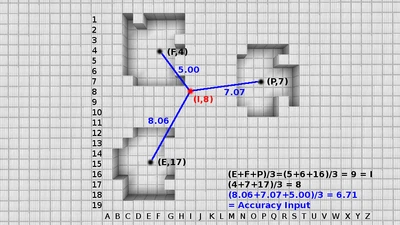
In the image to the right, the accuracy input is the boilerplate of the lengths of the blueish lines. The red dot is the average of the positions of the explosions, and an endpoint of each of the bluish lines, the others being the explosions. The accuracy value equation is (45-A)*2, where "A" is the accuracy input.
The power value is the number of TNT in the shot times ten.
The speed input is the distance between the front of the cannon to the boilerplate position of the centers of the explosions. The speed value equation is S/five, where "South" is the speed input.
The damage value is calculated using this equation: (((45 - A)*2) + (P*ten) + (S/5)) / three.
- Ergonomic value
Ergonomic value tells how hard a cannon is to build, higher values signifying easier build. It is the average of the construction, redstone, and TNT values.
The construction input is an estimate of the number of blocks in the cannon, excluding burn down, water, air, and TNT. The construction value is (m - B)/10, bold "B" is the construction input.
The redstone value is ten minus an approximate from one to ten of the complexity of the redstone, times ten; (ten-R)*10, where "R" is the gauge.
The TNT value is (fifty - T) * ii, and "T" is the number of TNT needed to operate the cannon at maximum chapters.
The whole equation to summate the EV is ((grand - B)/10 + ((x - R)*ten) + ((50 - T)*2)) / iii.
- Other
TNT amount, maximum range, and nickname are pretty self-explanatory, but to clarify, the TA is the same as the TNT value of the EV, and the MR is the distance from the front end of the cannon to the farthest explosion.
The nickname is whatever you proper name it, assuming it'due south not profane, and nobody else has already named a similar cannon.
This is how the 40.86:8.104 Bones cannon was named.
Impairment value = (((45 - 0 )*2) + ( i *10) + ( 104 /v)) / iii = 40 Ergonomic value = ((thou - 50 )/10 + ((10 - 2 )*10) + ((fifty - 8 )*two)) / iii = 86 forty . 80 : eight . 104 Basic
Technical names [ ]
A cannon'due south technical name should give its readers a consummate motion picture of its function, use, and method of performance. While it is impossible to anticipate every innovation in TNT cannon technologies, most cannons will benefit from using these standards in their technical names.
- The first number in a technical TNT cannon name designates how many horizontal rows(layers) of TNT it has for the charge. The case cannon has 1.
- The side by side number is the amount of shot TNT. Again, the instance cannon has i.
- Adjacent, the number designates how many charge blocks of TNT the cannon has.
- If there is a TNT condensation system, after the charge number, write a decimal betoken, then the amount of condensation charge TNT. If there is no such TNT, write 0 instead.
- A list of how many repeaters there are, and how much they are set up to. E.1000. If you accept x repeaters set to 4 (which is the maximum setting), y'all would list R4.x. If there are no repeaters, you would write an M for manual.
- The mounting block is designated by a code: 0 or 1 for no block, 2 for full block, iii for slab, 4 for ladder, glass pane, or iron bar, 5 for trapdoor, half dozen for contend post and force per unit area plate, 7 for piston.
- If the cannon does something special, like shoot vertically, or does a spread shot, write that afterwards the mounting block lawmaking.
- The nickname of the cannon goes here.
The featured TNT cannon above would be named 114.0R4.4M2.
Building materials [ ]
Survival mode [ ]
As discussed in basic concepts, there are many parts of a TNT cannon.
- Body
- Consider using a common material, such every bit cobblestone.
- In multiplayer, when firing against another cannon, attempt to utilise materials with higher nail resistance. (For more on TNT cannon defenses, await below)
- Another factor is visibility, which is i usually overlooked. When making a cannon out of obsidian, it is hard to run into redstone, and that tin pb to fatal errors. On the other stop, when setting up an ambush in the jungle, it is best non to make your cannon out of orange wool or lapis.
- Consider using a common material, such every bit cobblestone.
- Wiring
- At that place are two master sets of wiring in a cannon, the accuse wiring which activates the accuse, and the shot wiring that activates the shot.
- Without any repeaters, which can be hard to get, a cannon is designated every bit transmission, with 2 redstone power sources/blocks, such every bit buttons. For a manual cannon, the materials are uncomplicated, just a redstone wire that connects the accuse to a redstone emitting particular, and a wire that connects the shot to a redstone power source. However, this requires skill and so every bit non to misfire, you must know when to activate each button.
- With repeaters information technology is a unlike story. The maximum amount of time betwixt the charge activating and the shot activating is ten repeaters ready to 4. That will also bring you maximum range, volition only require ane redstone power source, and will crave no skill to burn correctly.
- At that place are two master sets of wiring in a cannon, the accuse wiring which activates the accuse, and the shot wiring that activates the shot.
- Mounting block
- Mounting blocks (described below) are only certain special blocks.
- Explosion housing
- Unless it's a dry cannon, this must be water or lava (in the latter instance, only source blocks). The liquid prevents the cannon and whatsoever other surrounding blocks from beingness destroyed.
Creative fashion [ ]
In creative mode, at that place is no reason to build a TNT cannon for warfare, but is the optimal style for testing and developing cannons.
Factions [ ]
In factions raiding with TNT cannons is the most common way of getting into a base. There are 2 main methods. The offset (on servers where enabled) is to airburst. This only works on obsidian with water outside. The cannon shot must have a delay so the explosion reaches the obsidian but the primed TNT must not exist in the water. These cannons will not work on other walls. The other method is with hybrid cannons which are explained below. The basic hybrid is one of the most normally used raiding cannons.
Limitations, and ways to possibly go effectually them [ ]
The five big, primary limits to TNT cannon engineering, ordered by importance, are:
- That no matter what you lot practise, a TNT will explode approximately four seconds or 8 flashes later being primed. The mode to sidestep this is to make the TNT fly faster, but that leads us to limit 2.
- Minecraft tin can only take and so much, and entities flying at escape velocity around your Minecraft globe tin crusade it to crash. Another thing that can cause crashes of your Minecraft is large amounts of impulse charges detonating in unison. With the allotted ane.5 GB of RAM, the max TNT is about 500. The way to possibly sidestep is to increment the RAM immune for Minecraft, although that is not recommended for lower end computers.
- TNT has a 7 block detonation radius, so just making a large cannon is a waste of time. Beyond 9 charges, the TNT is wasted. However, this can be sidestepped by either adding more vertical rows of charge to your cannon, adding a accuse condensing system to your cannon, or a combination of them both.
- TNT flows with the h2o while in it. This tin can exist skilful or bad, depending on the situation. The fashion to sidestep this is to utilize h2o source blocks, and don't identify any TNT within information technology.
- If yous make a vertical cannon too powerful, information technology will fly up too fast and high meaning it will crash your game. This can be sidestepped by decreasing the power of said cannon, or making information technology semi-vertical. That way you can get upward and sideways.
Cannon sizes and special features [ ]
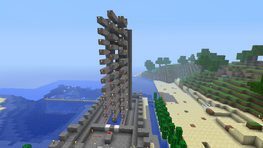
An example of a super big cannon
The default definition of cannon size is how many TNT are in the shot or how far it fires. If you are talking about meaty cannons, you might be talking most literally the size of the cannon (eastward.g. how much space it takes up) or if you are talking about cannons meant for mass destruction, you might be talking about the size of the shot. Only usually, people mean charge mass.
A small cannon, such as a 112.0MM3 cannon, only has a very small range, and is meant for stopping large amounts of rushing players or mobs.
A medium cannon, such every bit the 116.0R4.6M2 is meant for setting upwardly every bit a beginning line sieger, to be set up and aimed at a target such as supplies or a wall while i has arrow cover, or to be fix as an anti-archer cannon.
A large cannon, such as the 119.0R4.10M3 is for attacking from a distance, a borderline long range mortar, an anti-cannon defense, a second line sieger, and many other uses.
A sniper cannon, such equally the 119.3R4.10M6 is for a tent line sieger, setting upwards to shell opponents camp when they can't even encounter the cannon shelling them, and other out-of-sight range tasks such as that.
And of course, mass demo cannons, such as the 187.0MM6 spread-shot, which is used to completely mutilate any defenses whatsoever.
Players also like to add features to their cannons including:
- Multiple shots [1]
- Semi-automatic/fully-automatic firing and reloading [two] [3]
- Condenser accuse (another set of TNT that explodes, pushing the charge towards the front of the cannon to increment the propulsion force.)
- Safety features, such equally a smash shield to protect players/mobs from damage acquired by the charge exploding
- Adjustable shot delay
- Alternative ammo, such as arrows, sand/gravel, or anvils [iv]
- Dry out cannon: edifice a cannon from explosion-resistant cloth to simplify design, maintenance, and potentially better firing altitude (dry cannons fire farther than their wet counterparts, all other factors being the same). See below for construction details.
- Cannons that fire in a special direction, such equally up or diagonally
- Adjustable range, trajectory and management (aimable cannons)
- Spread shot/mass destruction cannons
- Shotgun-like charges
Accuse condensing [ ]
TNT-based condensing [ ]
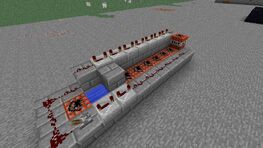
An case cannon with a Condenser Charge.
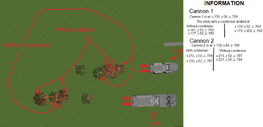
A comparison of the shot altitude of two unlike cannons, i shot with and 1 shot without a condenser charge each.
Because the force from an explosion is weaker the further away from its source, TNT placed more than 7 blocks from the projectile have little to no result. To remedy this trouble a condenser accuse may be used.
A condenser charge works by exploding slightly before the master accuse, with the intention to push other primed TNTs towards the projectile. Since the primary charge is closer to the projectile, information technology volition exist launched with more than force.
Piston-based condensing [ ]
Using pistons to button the principal charge closer to the shot also does the same affair as a condenser accuse, more than complicated to build but more controllable. To piece of work, the chief charge must exist primed, turning the solid TNT blocks into entities. Once they are entities, a series of pistons can push and concentrated all charges into a single block space behind the shot. In this organisation, you get far more efficient power from a given size of charge.[five]
Intendance must be taken then that the pistons practise not displace the h2o blocks protecting the cannon from TNT damage. To exercise this, one commonly has to apply water a block above the area where the pistons would go into. It is too advised that the pistons should retract back into normal position before the main charge explodes, or your cannon might be destroyed. When the pistons extend, they create air spaces in the water no matter what, hence compromising the water's protection.
Guide blocks [ ]
When a TNT charge is primed, it will unremarkably shift slightly to one side, which can reduce the accuracy of otherwise well-designed cannons. A simple solution exists: add guide blocks so that at that place is a wall on either side of the TNT when it is primed. This will forbid the TNT from shifting left or correct, resulting in a straighter shot, with less diagonal variance. If your design does not let for this, you could only make the guide blocks one block higher, instead of beingness on either side of the TNT. This works considering TNT will jump up, and so go sideways in midair. Note that in most basic cannons, guide blocks should be transparent if the TNT cannon automatically primes the shot-otherwise, the redstone that ignites the charge will power the cake next to the shot, and igniting the shot as well. If this explanation is unclear, look at this diagram:
In dry cannons, a guide block is almost a necessity considering dry cannons tend to exist inaccurate. Notwithstanding, dry cannon'due south guides are for directing the shot to be shot accurately, not to be primed accurately. Nonetheless, guides can likewise decrease range if they are too long.
Shot mounting blocks [ ]
The shot mounting block for a cannon should be chosen according to how fast, far, and high you lot desire the cannon to fire. Of course, these variables depend profoundly on the position and amount of the charge and the timing of the shot, merely the mounting block too can make a difference. For example, with a cannon with a accuse of 5 and a delay of R4.3, the shot will take a mortar trajectory with a ladder more with a fence post and force per unit area plate.
A few things:
- Even though the shot mounting blocks ladder and total cake are both the aforementioned peak and burn down a shot at the same trajectory, the ladder will consistently fire further than the total block because the ladder has less affair in between the shot and the accuse than the full block. This situation is the same for all mounting blocks, the slab and fence postal service with pressure plate too follow the same dominion.
- There is a trade off: although the fence post and force per unit area plate burn down the farthest, they are also expensive, while the slab is cheap and like shooting fish in a barrel to get, as well every bit coming in many forms.
- The maximum range for whatever cannon can be achieved by altering the mounting cake. A TNT shot will be fired uttermost if information technology leaves the cannon at a xxx degree bending. So, if yous desire to merely have your cannon get the uttermost information technology can, use the slab, contend and pressure level plate, or trapdoor mounting blocks. Still, when faced with fortifications or terrain obstacles, the all-time idea would be to have a mounting cake like piston, ladder, or single cake that makes the TNT arc over the said obstruction. But, and so again, it is fun to blast your style through things...
- The following shot mounting blocks are tested and deemed safe. Feel gratuitous to experiment with mounting blocks, but keep in mind that some blocks, such as a lone pressure plate, will cause a mis burn of your cannon, and of form make it self-destruct.
A rewrite for most of these mounting blocks is coming soon.
| Pros | Cons | Notes | Epitome | |
|---|---|---|---|---|
| No mounting block | Highest velocity, elementary, scalable | Poor range in smaller cannons, downward trajectory, line-of-sight but | When no mounting cake is used, the shot is launched from the aforementioned level every bit the TNT. It volition burn down out completely horizontal, or 0°. Gravity volition quickly pull the shot to the ground, giving a very flat, downward trajectory. With small TNT charges, the range can be extremely limited. To increase the range, ever larger charges are needed or the cannon must be built higher higher up the ground. A larger charge means a higher velocity to the shot, pushing it farther away earlier it drops to the basis. Players have been known to employ up to lxx TNT charges and beyond. Just economically, a cannon without a mounting cake will take more TNT and longer to load for a certain range. | 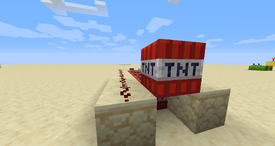 No Mounting Block |
| Single block | College firing angle, tin can lob shots | Low velocity, reduced power and poor range for smaller cannons, and it won't get as far. | A single full size block such as asphalt or obsidian is placed under the Shot. This has the effect of elevating the Shot above the water trough, so the boom strength from the Charge is practical not just forward, but upwards. The shot is fired out at a high bending and trajectory. This is useful for hitting an elevated target, or one behind terrain or obstacle. Withal, function of the blast force is captivated by a solid mounting block, and then the cannon will suffer like problems of needing large charge sizes. Likewise, since some of the free energy is expelled in the upwards direction, frontward shot velocity is reduced profoundly. A better culling to the unmarried mounting block is using a ladder instead. | 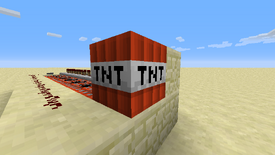 Unmarried solid mounting cake |
| Slab | Smooth trajectory (not also high, not too low), average velocity, more efficient for small and medium cannons | Slightly reduced power, not all-time for either straight or lob shots, fuse range limit* | A slab is the compromise between a unmarried cake and no mounting, and generally more efficient than either. More of a cannon'southward blast strength is directed frontward, merely at that place is all the same an upward vector that raises the bending of burn down to roughly 30°. As with a single block, some of the blast energy is captivated past the block, but much less. From the same TNT load, the half block has greater range than a unmarried block or no cake. When the TNT shot is initially placed over a one-half block, it will hang over information technology as if it was a full size cake. Once the TNT has been "primed", it will fall down and sit on the truthful height of the slab. The firing angle produced by a half cake is good for extending the range of a cannon and hitting elevated targets, only its too low for effective lobbing over high walls and obstacles. For straight direct firing, shots fired with a half block mounting generally land level on the basis within a certain range. However, due to the limited fuse time of TNT in the game, scaling up the TNT charges upward to a bespeak will event in the shot flight likewise high and exploding in the air earlier information technology lands or achieve the cannon's maximum range. This will be refer to equally the "fuse range limit". All cannons are limited past the fuse range limit, but cannons firing at higher angles are specially decumbent to the fuse limit, as the shot velocity is lower and shots accomplish higher altitudes. | 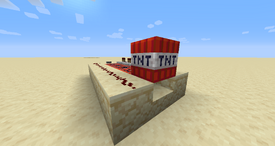 Rock slab used as a half block mounting |
| Trapdoor | Closed: Optimized for flat trajectory, velocity almost the same as no-block, have a very large range pregnant it can destroy far targets. | Be certain that priming circuit doesn't activate the trapdoor by accident. Very high speeds and oversized accurate shots could mean that if the primed TNT hits a nearby wall in the air, it will autumn down and miss the shot. It cannot aim at medium or high elevated targets | If the firing angle of the half cake is too loftier for your purpose, a closed trapdoor can be used instead. Like the one-half block, information technology provides some upward forcefulness to the shot by elevating it above the trough. A trapdoor's peak, however, is 3⁄16thursday of a total block. Firing angle is roughly 15-twenty°, making it extremely effective for straight shots at very long range (180+ blocks). Piddling forward velocity is lost when firing, and shot typically fly out at very high speeds. This combine with the low firing angle ways cannons firing larger loads can extend their range without encountering also much fuse range problems as with the one-half block or ladder mounting. | 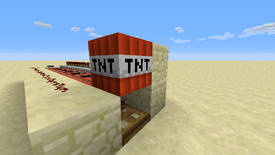 Trapdoor used equally a mounting block |
| Open: Tin can be used in open position for higher firing angle, adept scaling, can destroy higher targets | ||||
| Ladder, Atomic number 26 bars, Drinking glass pane | Efficient with small and medium cannons, high firing bending, parabolic trajectory, good for lobbing shots and high distance. | Low horizontal speed, poor scaling, limited range at ±120 blocks. | A ladder placed on the side tin serve as a very effective mounting block for firing at high angles and lobbing shots. A primed shot will be supported by the edge thickness of the ladder, preventing information technology from falling into the trough. Because a ladder is non a full size block, none of the free energy from the nail is captivated, and the shot is propelled out at total force. Past adding ladders higher up each other, different firing angles can be achieved. Typically, a single ladder volition give an angle just college than a half block, roughly 40°-45°. Ii ladders will give an extremely parabolic flight, shots wing out at about 50°-60°. A proficient portion of the blast energy is directed upwardly on the cake, so horizontal speeds are generally much slower than a no-mountain or half block mountain cannon. In return, the cannon has no problem lobbing shots over terrain and walls. At larger charge loads, shots can achieve very high altitudes. However, this also means the fuse range limit is an inherent trouble with this mounting. Within a 100 block distance, well built cannons level with the footing can wait to land shots depression enough to cause harm. But beyond this shots explode midair fashion beforehand, even with a shot primed at maximum fuse time with a delay circuit. Hence, ane can't simply add together more TNT to increase the range, as it will merely brand the shot fly college. A basic solution is to put the cannon beneath basis, in a pit with a slanted slope to permit the shot to fly out. Since the shot had a lower starting indicate, it will explode closer to the ground one time its fuse time runs out. To reach ranges beyond 150 blocks, this solution becomes impractical. | 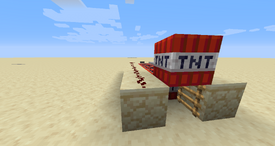 Ladder mounting block 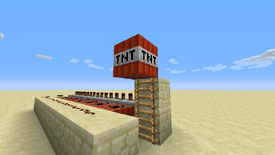 Shot mounting with two ladders |
| Fence | Efficient with small-scale and medium cannons, low firing angle, good for shooting through caves and past overhanging base defenses. High velocity, extremely powerful in spread cannons and long range cannons. | Expensive materials, fuse range limit to bigger cannons. If used a condenser, so the explosion volition ship the TNT too high and with no ceiling, the TNT can destroy the cannon. | A fence placed at the stop of the cannon tricks Minecraft to recollect that it is one block high, since it is only i and a half block high for the player's perspective. Therefore, the charge would be recognized every bit closer to the shot than it actually is. Since it gains more power and velocity, it appears to fly upwardly a bit, then go down in an attack angle. However, the explosion launches the TNT upwards significant if the cannon has no ceiling, the TNT tin well destroy the cannon. This gives it a distinctive style of cannon shooting, and it is considered one of the well-nigh useful mounting blocks in Minecraft. if the cannon needs the water blocked a pressure plate may be used, but slightly decreases the launch velocity. | |
| Piston | Adjustable, when fully extended it has the aforementioned effects of a full block simply is more efficient than it and is more versatile, uniform with firing sand or gravel. | Expensive, the shot has been subject to the fuse range delay limit establish in arcing cannons, is used as a mortar MB so usage within caves or buildings is not recommended and will consequence in short range shots, accidentally placing two TNT blocks (one on top of the other) will destroy the cannon, requires a R4.7 delay. | The three nearly mutual means to use this mounting block are
|  A TNT cannon with piston mounting. |
| Rarely used mounting blocks | ||||
| Flower pot | Can lob shots. | Fuse range limit, expensive, cannot aim at lower targets | ||
| Redstone repeater | Second highest velocity. | Can but shoot 9 blocks, expensive, make sure the circuit doesn't activate it by accident. | This cannon is only used in an farthermost hills biome. It only works if the cannon is on a cliff and the target is beneath it. | |
| Daylight sensor | Expert shooting, not too high velocity, can lob shots. | Make sure the sensor doesn't activate the circuit past blow past daylight, expensive. | This is a cannon for ground levels and it is skilful on any type of cannon (except of super large cannons which has a fuse range limit.) | |
| Bed | Expert shooting, really fast, medium-high bending. | Expensive, bigger cannon | This is good for attacking bigger castles, just has also a large range. One of the best mounting blocks. | |
| Cake | Good shooting, medium angle, big range. | Expensive, cannot be retrieved. | This mounting block is practiced for attacking far targets if yous have resources. It has smaller footprint which means that charge TNT can exist closer to the shot than when using slabs, thus increasing the range. | |
| Brewing Stand | Loftier fire angle (similar to ladder), exceptional range, loftier velocity | Expensive, ineffective against level targets | Brewing Stands will shoot TNT slightly slower (and lower) than a ladder, but the difference doesn't show easily. Likewise allows you to brew regeneration potions while you shoot to help you recover the recoil damage. | |
| Enchantment Tabular array | High blast resistance, capable of striking all distances. | Very expensive. | Enchantment Tables burn down shots a lot similar slabs. Practice note that the rotating book will not have whatever effect on the trajectory. | |
| Stairs | High fire angle | Low velocity | Inverted stairs are useless; mounting a shot on one has a very high chance of blowing up your cannon and/or diggings the nearby landscape. | |
Cannon tutorials [ ]
Dispenser-based cannons [ ]
An case cannon using dispensers
Note: the example cannon needs modifications to work in Bedrock Edition because dispensers still make TNT hop ending upwards with the outset TNT destroying the machine. This tin can be fixed by putting that dispenser on a separate water flow that goes into the same block, also assuasive for long range cannons.
Since the Redstone Update, redstone dispensers manipulate ignited TNT instead of dropping information technology. This feature can be used to brand better automatic TNT cannons.
The cannon to the right uses dispensers to release TNT into the h2o. When you press the push button, first the long row of dispensers volition fire. After a 33-tick delay made the repeaters, leftmost dispenser will dispense the last moment before the TNT detonates, giving the shot a longer range. Note that the leftmost dispenser is higher than the other dispensers, and that the water should be flowing towards the forepart of the cannon. Dispensers dispense TNT without the feature "hop" of ignited TNT, which helps ensure the TNT will land in a much shorter radius than a conventional TNT cannon.
One of the smallest TNT cannons is this design by Mumbo Jumbo:
You can hands modify it to have another dispenser under the water facing upwardly, and you can use a fence post with a pressure plate on meridian instead of a slab.
Pros: The fourth dimension taken to reload TNT is at its absolute minimum. All a player has to do is to brand certain the adjacent shot is placed after the first shot is fired to make sure you don't destroy your cannon. This cannon requires petty skill at all to fire; the hardest part will be placing the cannon a proper distance away to make sure y'all don't over/under-shoot. Such precision makes this cannon practiced for castle defense force. Furthermore, through utilize of comparators, it is possible to brand an hands aim-able dispenser-based cannon, and dispenser-based cannons do not accident themselves up if hit with another TNT cannon.
Cons: Dispensers and TNT are expensive. This type of cannon tin never be quite as hardy every bit manual cannons, since dispensers can be blown up with TNT. Furthermore, if the cannon is left loaded and unattended, information technology is little to steal the TNT from its magazine. (This is also truthful of conventional auto-cannons.) Dispenser-based cannons with a one-block-broad water pool accept as well been known to accident themselves upward, specially if left firing automatically and unattended.
An automated cannon can hands be fabricated with this design. Substitute the button for redstone and hook the redstone upwards to a clock. Be conscientious not to ready the clock nether 4 seconds, the same time as information technology would take the TNT to explode. If the TNT is reloaded too quickly, the timing tin can cause the shot to detonate before the propellant does, destroying the entire cannon.
Reloading cannons [ ]
Traditional [ ]
Reloading cannons are i of the well-nigh complex designs for beginners. However, as long as close attention is paid, for a first time build, information technology can be created in about 15–20 minutes depending on the size. Reloading cannons became obsolete when dispensers were added (except in the console editions).
The Good: Reloading TNT cannons can be customized only as easily as whatsoever other cannon (using fences, fe bars, glass panes, etc.). They tin be shot several times with only a few seconds' interval in opposition to having to reload it several times like you lot'd have to practice with a standard TNT cannon. Using the simple pattern, this TNT cannon can have up to 12 rounds in the magazine. If playing a fortress war server, this cannon tin can burn down repeated shots which will demolish the enemies' buildings before they have fourth dimension to stuff their ammunition into their puny and inferior weapons.
The Bad: Unfortunately, cannons of this variety are bulky and frequently unattractive. They require sand or gravel which are nonrenewable resources in survival mode. Added to that, information technology is tedious to reload the cannons whenever the magazines run out of ammo, however occasional that may be. With standard TNT cannons, if the 1-round magazine is destroyed, it is usually hands replaceable. This is non the case with the reloading kind, equally the entire magazine will explode, destroying the weapon and all the redstone wiring with it—often killing yous in the process. This blazon of cannon has also become redundant with the recent updates allowing automatic cannons utilizing dispensers to reload the tnt, which is easier and more meaty to make.
-

Footstep 1. Brand the framework. Begin with a standard design, but make a few modifications and then that it looks similar this. (Framework)
-

Then, y'all should get out a bucket of water and pour it down the slot like you would with whatsoever other pattern. Make sure to place a block hovering over the source block then you won't accidentally place something in it.
-

Toss in the wiring and yous should become...
-
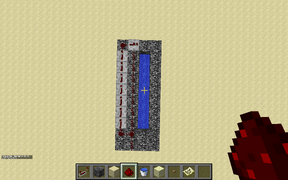
…this!
-
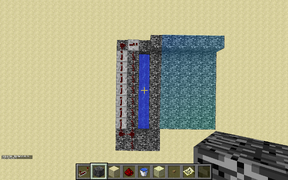
Footstep 2. Make the magazine. This is where the TNT is going to be pushed and loaded into the firing chamber. It tin can store upward to 12 rounds, but this one will be made with 7. Now we need to add together pistons that will push the TNT towards the chamber, and so place this following
-
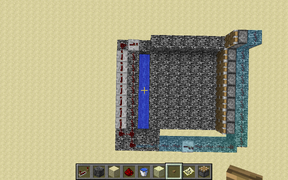
-
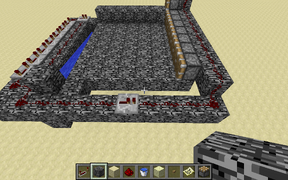
By the cease of that, the cannon should look like this.
-
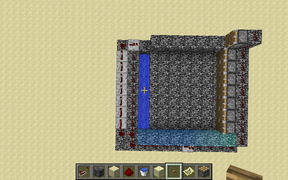
Step 3. Work on the chamber. Information technology's of import to separate the bedroom and magazine wiring from the TNT.
-
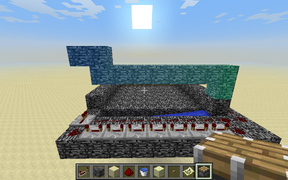
This weird design should go correct higher up the bedchamber.
-
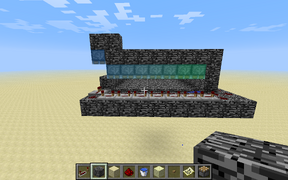
Now we're going to adhere pistons to it that will shove the TNT into place
-
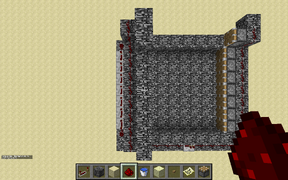
An aerial view...
-
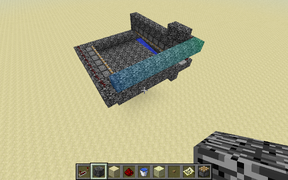
Step 4. Connect the bedchamber and magazine wiring. Add together this to the framework
-
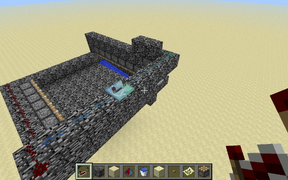
And the wiring...
-
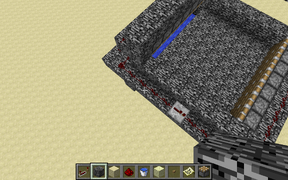
Step 5. Brand a trigger. Go to this area.
-
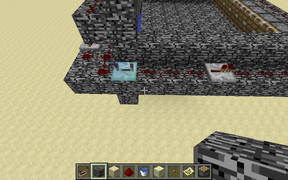
Next, nosotros need to supplant redstone dust with a repeater.
-
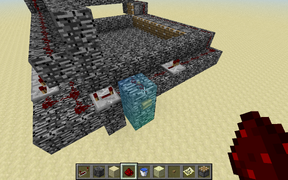
Nosotros're almost done! Merely identify the igniter, now.
-
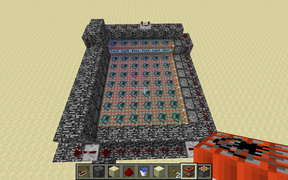
Footstep 6. Affect upwards & check for bug. I purposefully planted a few bug. Start, some of the wiring is in the way of the barrel which will severely damage the range. We'll become to that later. More importantly, we demand to motion one of the repeaters ahead because information technology isn't providing enough power from where it is. Step 7. Load the magazine. Pay shut attention to this part equally you will have to practise information technology every time you reload the mag. Place the TNT into the magazine, from against the side-pushing pistons...
-
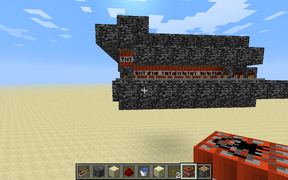
…to the top-right border of the chamber (NOT underneath the down-facing pistons, but right behind that area).
-
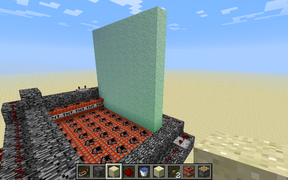
Now nosotros need to put sand within the magazine. You'll take to do this every time, besides. Put 8 stacks on top of the TNT pushed against the left-facing pistons.
-
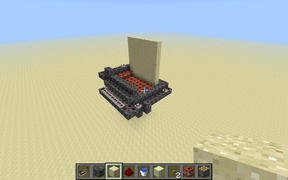
And there you lot go! This is what you should run into.
-
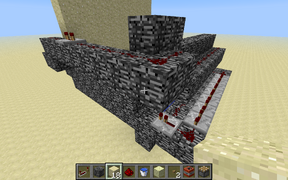
Step eight. Finish upwardly. Yes, yes, I promised to fix the wiring in the style of the chamber. Here's the trouble.
-
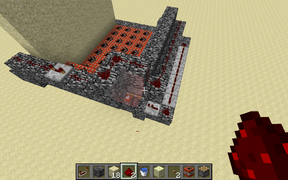
This is how you set up it. Information technology'due south relatively simple. Make sure there're no more than blocks in the way and you lot should get this when you burn.
-
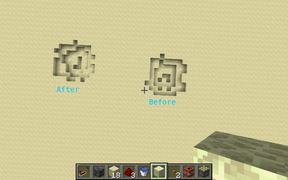
This is the result of fixing the stuff in the way.
-
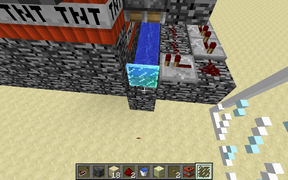
You lot may also want to put in a mountain (as mentioned in a previous tutorial) to maximize operation! Here'southward a glass pane mountain.
-
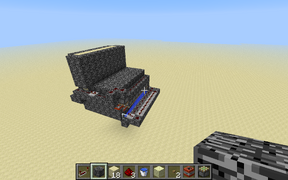
Additionally, consider covering the hull of the cannon to prevent opposing TNT cannons from blowing yours up!
-
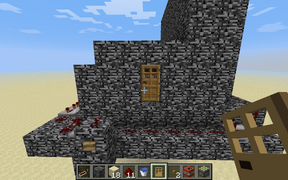
Whatever you do, just make certain there's a door that leads to the magazine and that the sand-sleeping room is accessible from the top and so you lot tin reload it!
-
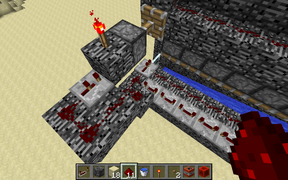
One more matter you tin can add is this piston. It will pull away the down-facing accuse piston so that it isn't in the mode when it's firing. And… that about wraps this tutorial up! Experiment with the cannon and exam to encounter what mounts fit your needs. Brand sure to pull the ammunition out of the magazine before yous test blindly—I can imagine it wouldn't be much fun to sentry something that took this long to build fly to pieces!
Dispenser reloading [ ]
In order to avert having to manually place TNT into every dispenser of a cannon, some more modern cannons take been designed to use a minecart or hopper organisation in order to distribute a big stack of TNT from one location such as a chest into all of a cannon's dispensers. There are issues to using such systems, primarily that nearby minecarts may intermission if the cannon's charge is too powerful, and the necessary redstone circuitry and hopper designs may be deemed too large or complex to exist practical.
The Chaosrider design for the 112.0R1.2R4.1M6 Reloading WOLF uses minecarts and hoppers in a compact and semi-efficient mode:
Short-middle range cannons [ ]
Cannon [ ]
You lot will need: 14 edifice blocks, 4 dispensers, 4 redstone grit, six redstone repeaters, 1 bucket of h2o, 1 button, i contend, one pressure plate and at least 4 TNT.
- Build a U-shaped frame using building blocks and dispensers, ane block above the ground. It should be 6 blocks long and 3 blocks wide and the dispensers should be facing towards the center of the U shape.
- Add together 3 blocks to the front of the U-shape. These will help guide the beat. Now add a concluding dispenser, facing towards the cavalcade of blocks.
- Add three blocks in the center of the U-shape, one block lower than it.
- Identify a debate post and a pressure plate in front end of the cannon, so add water running towards the force per unit area plate.
- Put redstone dust over the ii dispensers (you will have to hold down shift key to do this) and so over the furthest dispenser, put a block on meridian of it and then put a push button on top of that block.
- Finally, add Redstone repeaters to the remaining spaces and put redstone grit on the conners. Every redstone repeater has a four-tick filibuster except the Redstone repeater pointing to the upper dispenser.
- Finally, fill all 4 dispensers with TNT and requite it a try!
Super Quick Raid Cannon [ ]
Pros: Very elementary
Cons: No water ways terrain damage. Can impairment you a lot. Requires a bow
This cannon simply requires a flame bow, two arrows, and eight TNT (though you lot'll want to use either water or adept armor). This was made by reddit user Zecon 365 hither
"The Pulverizer" - An Ultra Rapid Automatic Slime Cannon [ ]
A simple and compact cannon that can cause massive destruction. Information technology utilizes an extremely quick timer to dispense and propel the primed TNT with the assist of a slime block.
Vertical TNT cannon [ ]
This is a simple TNT cannon to rebuild. It is very efficient and shoots you very high in the air.
| Vertical TNT cannon (view on YouTube) |
|---|
Downwards TNT Cannon [ ]
This cannon has very few uses, simply can exist used instead of a gravity fed TNT dropper.
3x9 Pressure level Plate [ ]
Pros: like shooting fish in a barrel to build, understand, and use
Cons: whatever mob tin accidentally use
This cannon requires h2o, redstone, whatever block, TNT, and pressure plates. Make a 9x3 rectangle, break the heart of a iii on one side, and put 2 more blocks on both sides of the hole, straight up on the blocks. Pour water into the other side, and place TNT everywhere simply source, and between the highest blocks. Make stairs downwards one side of the loftier areas, identify redstone on the stairs, 1 cake away, then add a pressure plate. Place redstone along the frame until you go to the high points. Put three redstone by the far corner by the stairs, and place another pressure level plate. Stride on that, wait a count of three or 4 secs, and then go step on the other plate. The loftier TNT will fly out up to about 50-60 blocks.
Notation: The h2o source neutralizes the lower TNT to forbid devastation.
One-push button defensively ranged cannon [ ]
Repeater used every bit delay [ ]
It is a uncomplicated cannon that has an automatic delay. Used mostly for republic of guinea pigging other, larger, prototypical cannons or every bit wall mounted defense against basis- based troops or artillery.
114.0R4.4MB2 - The naming system for information technology can be establish to a higher place.
-

Get-go build the base of the cannon
-

Then fill it with water on one side
-

Build 2 blocks like on the picture
-

Place the button
-

Place the redstone wires on one side
-

On the other side, place a redstone torch and 4 repeaters on highest delay
-

At the front end identify another block with a torch on the side
-

load the cannon like this...
-

...and finish.
Minecart used as delay [ ]
One time yous activate the switch, first it activates the charge wiring, and so sends a minecart around the cannon that triggers a detector track, which primes the shot. Saves redstone, but takes a lot of iron (However, if you get rails from abased mineshafts this pattern tin even save yous resources!).
| Minecart delay (view on YouTube) |
|---|
Dispenser used as delay [ ]
Once y'all actuate the switch, first it activates the charge wiring, so shoots an item out of a dispenser that volition slowly autumn downwardly through a pressure plate on a argue and burn. Saves redstone, and requires no repeaters for those survival cannon engineers, Over all, information technology's cheaper than the blueprint to a higher place and normal automatic delay cannons with repeaters used as a filibuster.
| Dispenser delay (view on YouTube) |
|---|
Human (or other entity) launching cannon [ ]
Once this cannon is set upwardly, then it can exist used in social club to launch entities onto other objects or areas of the map. Information technology can be a trivial difficult however to go the entity within the cannon,if it'due south something other than a man. (this can be done by putting the entity in a minecart and using runway to become it in)
| Human launching cannon (view on YouTube) |
|---|
Ender cannon [ ]
This type of cannon is easily synthetic, very powerful (practically infinite) yet flexible with its charge and hilarious to scout unfold. The only downsides are that information technology requires an active ender portal and y'all will need to be in creative to survive maximum charge. Information technology operates on the principle that the fuse timer on primed TNT is reset to 0 when information technology passes through an end portal. This ways that a potentially space amount of TNT can be used equally a charge, simply by condensing it into 8 blocks of space. Minecraft volition not detonate them until you are in the end, thus making the figurer itself the limiting function.
Vertical launcher [ ]
This cannon, often called vertical launcher, other times chosen "Fireworks cannon" tin can be used to launch TNT blocks vertically, so that they can explode whilst midair.
| Vertical launcher (view on YouTube) |
|---|
Long range cannons [ ]
For long range cannons it is best to utilise a cannon with multiple rows of TNT for the charge, and depending on the elevation of your cannon, playing around with mounting blocks helps. If you add multiple shot TNT to your cannon, and play around with where yous place the TNT in your cannon, so you can effectively destroy anything in the cannons path.
3X3 TNT Minecart Cannon. https://www.reddit.com/r/Minecraft/comments/7w4qsr/3x3_tnt_cannon_with_adjustable_range/dtxfx1b/
Anvil "Baseball" cannon 1280M3ANVIL Cheaper Cannon that uses Eight Accuse Pieces of TNT to launch 1 to ii anvils upwardly to 75 blocks on Footing Level and Farther at a Higher Summit Is Congenital by simply Wiring upwards Eight Dispensers to a Single Lever without a Delay and a H2o Stream moving towards the 2 Anvils that are Mitt loaded over an Upward Water Column that, If done Right, will crusade the Anvils to Leap up and Downwardly, the Cannon casing should contain a Slab preventing the TNT from Reaching the Water Column and a Basic Surrounding case. To burn down Pull the Lever in one case when Both anvils are Staying depression on the Water Cavalcade, By the time the TNT fires the one anvil will be leaping Loftier, and if it is at the Apex of it's Leap, Will exist Launched High into the Atmosphere and out of Sight. The Cannon gets the Baseball name due to the Similarities betwixt it and Trying to striking a Ball floating on a Jet of Air with a bat. Currently Working on Adapting information technology to Launch TNT.
Y'all tin can also try TNT missiles. They become infinitely long until they hit a block in their path. So as long as you load the chunk they fly in, you can launch a missile from any altitude and hit a target if y'all aim correctly. Here is a archetype minecraft missile: https://www.youtube.com/watch?v=O-HA--BKuOs
Automatic cannons [ ]
Select fire, select range TNT cannon tutorial [ ]
This is a very complex design that is capable of selecting 7 ranges. Information technology is also capable of firing in semi-machine, full-motorcar and 3-round burst like the H&K MP5 submachine gun.
RailCannon Design [ ]
A elementary blueprint using a bug with TNT minecarts, using multiple minecarts to simultaneously explode causing projectiles to be launched into the air. This cannon uses less TNT than traditional methods previous of 1.v and launches projectiles much further.
L0:
L1:
Dispenser-based [ ]
L0: Solid base, 3X9, commonly buried 1 layer downwards
L1:
L2:
L3:
- Remember that all repeaters must be set to their longest setting.
- Note that obsidian was used here to reduce the possible damage in case of misfires, but feel complimentary to use any other potent, solid block.
- An improved fully automated shotgun mode cannon tutorial and demo tin exist found hither [6]
- Make certain all the dispensers face into the barrel of the gun and remember that only the first water block at the back is a source cake.
- Also by using pipes of hoppers attached to the backs of the dispensers, 1 can more easily distribute stacks of TNT from a primal point, such as a chest.
- Feel free as ever to improve the design. Happy hunting!
Specialized cannons [ ]
Launcher Cannon [ ]
Launcher Pads [ ]
A launchpad is like in design to a TNT cannon, simply instead of launching horizontally, information technology launches vertically either straight up or at an angle, depending on the design. There are many ways to create them, only some methods are more efficient than others. For instance, a simple design would be the cross pattern, as shown below.
This is what it would look like from higher up:
To load it, place TNT on the flowing water blocks.
The above design can easily be expanded in size and improved, only it is one of the easiest designs to build. Another simple design, yet much more powerful, is here:
| YouTube Video (view on YouTube) |
|---|
Another powerful design, using dispensers to place the TNT is built as following:
-

Layer 1
-
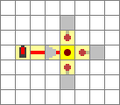
Layer two
-
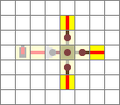
Layer 3
-
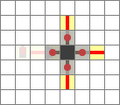
Layer 4
-

Layer 5
The night blocks on the last two on the right correspond dispensers, facing the center. If you want this to be reusable, identify a h2o source between them. A force per unit area plate filibuster is plenty for each dispenser to shoot twice. An interactive version is here: [7]
Aerial TNT Dropper [ ]
Every bit of Minecraft 1.5, dispensers at present dispense ignited TNT. Thus, down-facing dispensers tin can rain TNT on anything nether it.
Pros: This is a smashing way to bomb enemy bases without retaliation. TNT cannons cannot fire straight upward, or risk blowing themselves upwardly. It tin hands blow its way to bedrock. In bases with water over them, sand tin be dropped from above.
Cons: This cannon is useless in factions servers which take block protection over bases, every bit this requires this to be direct above the base. It is extremely resource-heavy, equally so much TNT is used. This has less range than a downward facing TNT cannon.
This trap is very unproblematic: Get up high, build a platform, place dispensers downwards, gear up a clock, and watch equally your enemy's base is obliterated. But block-pillar upwardly to a expert superlative. Do not build besides high, as the TNT would explode in midair, uselessly. Build the platform directly over the target. Place dispensers and fill them with TNT. Set a Clock circuit to trigger the dispensers, but exist conscientious! Setting the speed too fast will take the waves of TNT literally launch up and destroy your cannon. You can mine the dispensers subsequently. Every bit to the trouble of getting dorsum downwardly, you could use water, simply Ender Pearls could come in handy.
Anti-water defence cannon [ ]
It fuses sand and TNT together to blow upward blocks covered with water. Water is the enemy of TNT cannons, and this one works effectually it.
| Anti-water defense cannon (view on YouTube) |
|---|
Aim-able T gun [ ]
This cannon is shaped like a T; the mode information technology works is that information technology drops the shot in vertically on top of a mounting blocks between ii smaller troughs that can be filled with TNT to change the shot's horizontal launch angle. You can adjust the range by non filling the main trough all the way. Smashing for putting in a castle to destroy enemy artillery!
Elementary T-Gun Tutorial
Arrow cannon [ ]
An arrow cannon technically does the same job as a dispenser merely with greater range and area-of-effect. The general way to make these is to have a piston extended over where the mounting block on a normal cannon would exist. This would be hooked to a repeater string exactly 9 repeaters long, then inverted to go on the piston extended. The rest is simply the accuse trough, wired up like a normal cannon. Then employ a bow to deposit arrows on the piston caput, load the charge trough, and printing the button. What happens is: right earlier the TNT explodes, the piston retracts making the arrows fall. So the TNT goes off, launching the arrows long distances. This cannon is commonly used in generally mid-range scenarios where damage to blocks is unwanted.
Here's another design:
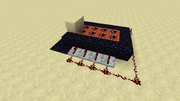
This cannon uses sand as a mounting block for the arrows. Note the delay on the repeaters.
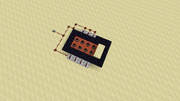
The cannon displayed uses a delay to interruption the sand on the upper-front end and advance the arrows. Below the beginning epitome is a top view.
Sand cannon [ ]
Sand cannons are a variation of the TNT cannon that is harmless. The concept is the same, but uses sand as a projectile. Also, the sand must exist falling as the TNT in the cannon explodes, shooting the sand, otherwise, nada happens. It is possible to pile the sand upwardly to make a "sand shotgun cannon", which can burn multiple sand blocks at different distances. Notation that the sand cannon generally merely fires in ane direction and is not destructive. It can exist used for pelting sand at people'south plots in creative multiplayer plots servers, and in turn, making moderators mad. Sand cannons are also unremarkably used by griefers on multiplayer servers. While the victim is doing renovations on their claimed land, griefers may build a sand cannon equally quick as possible as to non being caught, and fire several blocks of sand to the superlative of the victim's house while they are doing construction in hopes that they will break a block on their roof and have sand fall on summit of them.
Sand falls at a unlike speed than TNT does. Equally a upshot, information technology isn't possible to make a TNT-sand variable cannon that uses sand to decide where the cannon will launch its TNT to. Notwithstanding, it will burn the sand at the aforementioned horizontal bending if using an aimable cannon.
To build a sand cannon, use a piston to button the sand off in front of the TNT charge, or a gluey piston fastened to an inverter to remove a block holding the sand up.
Annotation: Sand is not the only affair that tin be used. Anything that falls can be used, and this includes:
- Gravel
- Anvil
- Dragon egg
Note that anvils and dragon eggs will not be pushed by pistons, so but the 2nd method described above for building will work for said blocks.
Dry cannons [ ]
A dry cannon uses TNT to launch TNT (or even the user on creative mode). Dry cannons are simple, like shooting fish in a barrel to build and effective but require lots of obsidian or other blast-resistant materials.
The primary deviation between a dry cannon and other designs is the lack of water and the use of a wadding block.
- The charge is a big corporeality of TNT that propels the shot. All of these TNT blocks must be ignited simultaneously.
- The wadding cake can be whatever blazon of block (except obsidian, bedrock and any other blast-resistant blocks) and provides a buffer betwixt the charge and the shot. Sand, snowfall, wool and other soft blocks seem to produce the all-time furnishings.
- The shot is a block of TNT or the user if you are on creative mode and drop into position on time.
Vertical cannon [ ]
- This design is a vertical cannon merely can be turned horizontally as well.
- The cannon is built entirely of obsidian.
- Outset by building a 5x5x4 rectangular prism, leaving a 3x3x2 chamber inside.
- Brand a hole in the summit center of the prism.
- Place one piece of obsidian on the center block at the bottom of the chamber. This is the mounting cake.
- Load bottom layer of chamber with TNT. This is the charge.
- Place the wadding on tiptop of the mounting block.
- Identify the shot on the wadding.
- Provide a redstone excursion then all the charge blocks are activated simultaneously.
- Stand back and throw the switch!
Horizontal cannon [ ]
Make a long tube of obsidian (works best with 3x3x6 or 3x3x7) with a hollow middle. So, put ii blocks of obsidian on the top. Hollow it out. Fill up with TNT, and put an non-blast resistant cake in the terminal infinite on the forepart. Cover the top with redstone, and place a button on the back. Optionally, brand a platform to stand on when you trigger it. You should also arrive a little ways off the ground. See diagram below, in which the orangish stands for the wadding (shown in cutaway side view):
It volition launch several blocks of TNT at your target, nonetheless it is expensive and does not have a very long range, but with a big cannon, you tin can shred a large corporeality of land with each shot. Occasionally the redstone volition be blasted off if y'all have a big cannon, so it is skillful to keep some redstone on hand. Proficient for the defense of a village (blast mobs with a row of cannons when they come up too close!). All-time for creative style due to the large amount of TNT needed for each shot.
TNT catapults [ ]
Slime blocks, introduced in 1.8, can bounce entities to certain heights. They can also push other blocks with them when pushed by pistons. These machines make use of this concept to make TNT catapults.
Pros
- They are very cheap to build.
- They are decently long ranged and burn down in an arc.
- They use much less TNT than other cannons of their skill.
- They can be fired extremely apace.
Cons
- It tin can exist difficult to obtain the pistons and slime blocks needed.
- The catapult has a stock-still target and express range.
NiceMarkMC's design [ ]
Morzeysminecraft's Design [ ]
http://www.planetminecraft.com/project/the-missile-silo-facility-360-caste-tnt-cannon-aimable-and-awesome/
TNT lifter [ ]
A TNT cannon might shoot TNTs far away, but non high upward. this design uses an ordinary cannon, merely uses slime blocks to launch it higher.
Video examples [ ]
- Mortar - Loftier angle shot using a ladder mounting block.
- Compact - The shot is primed by hand, which must at present exist done with flint and steel
- Super large cannon - Firing other entities.
Trivia [ ]
- TNT cannon firing is the most random event in Minecraft, considering of thousands of different sample points taken to determine dozens (or even hundreds) of different vectors which are so added together to form the base of operations trajectory of a shot. However, it is possible to make some cannons, especially vertical mortars, 99% accurate (the charge falls back into the barrel and detonates at a specific height).
- If yous're really lazy and have operator privileges (or in singleplayer with cheats), you can just employ commands or control blocks instead. The control
/summon minecraft:tnt ~ ~two ~ {Fuse:12,Motion:[1.0,0.0,0.0]}will fling a lit TNT east, starting from just above your head. - TNT cannons tend to burn further when facing east or south.
How To Make A Tnt Launcher In Minecraft,
Source: https://minecraft.fandom.com/wiki/Tutorials/TNT_cannons
Posted by: rowanforpets.blogspot.com


0 Response to "How To Make A Tnt Launcher In Minecraft"
Post a Comment